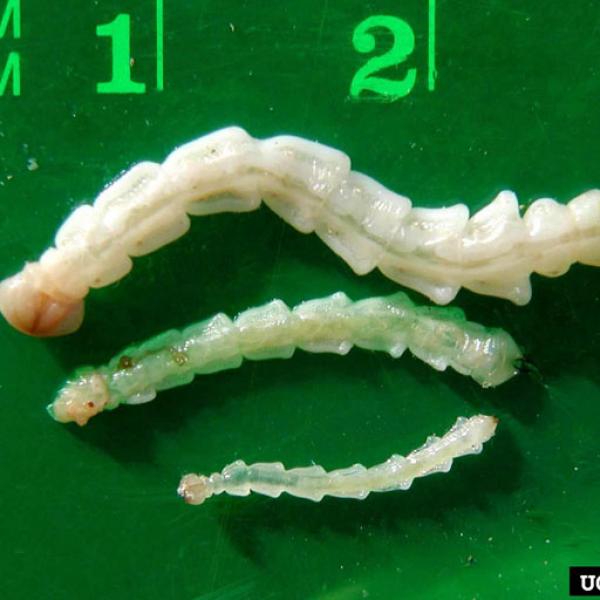
News Source
In October 2014, researchers at Wright State University discovered that an invasive insect called the emerald ash borer (EAB) was attacking white fringetrees (Chionanthus virginicus) in addition to ash trees. This was big news at the time. The EAB had already killed tens of millions of ash trees, and the fact that it could harm another species made it even more devastating.
Now the same researchers have found that the EAB can also successfully complete development on olive trees. Professor Don Cipollini has found that the invasive green beetle can feed and successfully develop into adulthood on stems of the Manzanilla olive tree, a Spanish variety that yields green table olives and is grown widely around the world.
“We are showing in this experiment that emerald ash borer indeed can complete development on olive,” said Cipollini. “It would add a potential pest to the olive cultivation industry. If we see this happening in nature, it could be a huge deal.”
Native to Asia, emerald ash borer was first found in the United States near Detroit in 2002. It is believed to have been in ash wood used to stabilize crates during shipping and may have arrived without notice a decade earlier. It is estimated that the borer will have caused $10 billion in economic damage by 2019.
The borers attack trees by laying their eggs on the bark. The serpentine feeding galleries of the larvae inside the bark disrupt the flow of nutrients and water and starve the tree.
Cipollini acquired a stem of the Manzanilla olive tree from collaborators in California and inoculated it with emerald ash borer eggs. Eggs were placed on the stem in February, and the larvae were allowed to feed on it for about two months. Beginning in April, Cipollini and Donnie Peterson, an environmental sciences Ph.D. student from Black River Falls, Wisconsin, exposed them to cooler temperatures for two months to simulate winter in order to facilitate their development.
Some of the larvae were able to chew deep into the wood and form pre-pupal chambers, where they grew into adult beetles. In early September, after being returned to room temperature for two months, several beetles began to bore their way out of the stem.
On one particular day, Cipollini and Peterson were huddled over the stem, which had been placed atop a cinder block outside the greenhouse at Fawcett Hall. A beetle was slowly boring a hole through the bark from the inside. Its head was bobbing and legs flailing as it tried to free itself.
“It’s too early to speculate on how much of a problem the borers would be for olive trees, even if they do attempt to use them as a host,” said Cipollini. “These trees are tough. They can live to be 1,000 years old. But there are certain pests that can impact or kill them. We just don’t know how damaging this could possibly be.”
Cipollini did the experiment with an olive tree because it is a close relative of white fringetree. Both trees are in the same plant family as ash trees.
The first trial was done in the spring of 2015 on small stems of potted olive trees with a previous environmental sciences Ph.D. student, Chad Rigsby of Springfield, Ohio. Three weeks after placing eggs on the tree, the researchers peeled back the bark and found a number of living, feeding larvae.
“That was the first ‘aha’ moment,” said Cipollini. “It was ‘Holy cow’ and ‘Oh no.’ It’s one of these things where it’s very scientifically interesting, but concerning at the same time. It signaled that more work needed to be done and immediately.”
A second laboratory test on stems from California was done in the summer of 2015 and had the same result. The most recent test was on a larger olive stem that would last longer in the lab and be a better food source for the larvae.
Cipollini and Peterson have tested the vulnerability of only a few varieties of olive trees to the ash borer. However, they have acquired several additional varieties of live olive trees in pots in order to expand their scope. So far, they have observed feeding by larvae on live trees of some varieties that was significant enough to injure the trees.
Cipollini plans to next find out if adult ash borers are attracted to olive trees in the first place, if they will lay eggs on the trees in the wild, and if they can survive by feeding on the leaves.
“This is entirely a laboratory project at the moment,” he said. “We have not yet observed anything happening out there in the wild.”
The U.S. olive industry is relatively small but geographically widespread. Most olives are commercially grown in California, but they are also grown in Arizona, New Mexico, Florida, Georgia, Texas, and Oregon.
“The olive industry is already battling a number of pests, including the olive fruit fly,” Cipollini said. “This would not be good news for that industry.”
He said emerald ash borer is also pushing its way into Europe and that ash trees overlap with olive trees in the Mediterranean basin.
“So it is certainly possible that emerald ash borer could contact olives in major olive-growing regions through its use of ash trees,” he said.
Cipollini presented these results at a USDA-hosted emerald ash borer research and technology development meeting in October at the Ohio Agricultural Research and Development Center. He is also preparing a paper for publication with Rigsby and Peterson as co-authors.
See more on YouTube: https://www.youtube.com/watch?v=YE6vEl1ZAWE
Photo Credit: David Cappaert, Michigan State University, Bugwood.org.